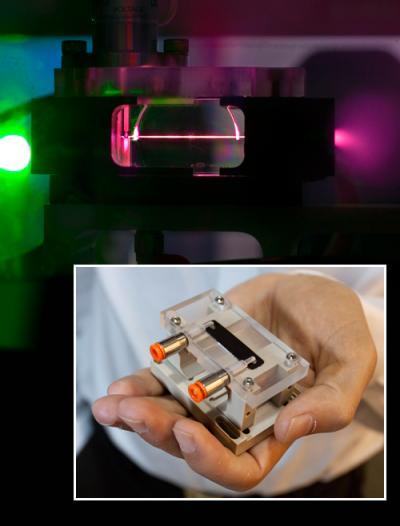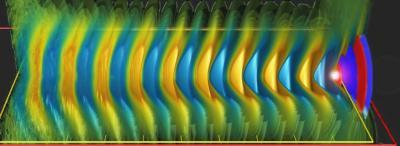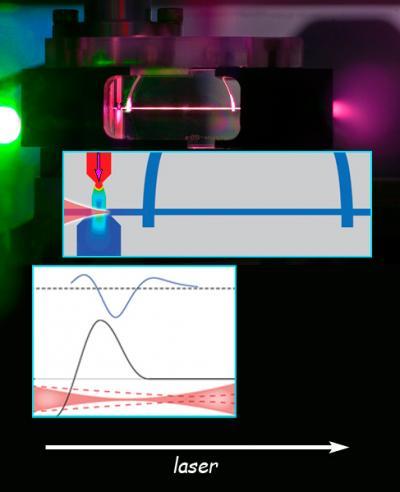Laser plasma accelerators offer the potential to create powerful electron beams within a fraction of the space required by conventional accelerators – and at a fraction of the cost. Their promise for the future includes not only compact high-energy colliders for fundamental physics but diminutive sources of intensely bright beams of light, spanning the spectrum from microwaves to gamma rays – a new kind of ultrafast light source for investigating new materials, biological structures, and green chemistry. Compared to today's giant science facilities, "table-top" laser plasma accelerators may eventually be able to do equally powerful research with minimal environmental impact.
To reach these goals, laser plasma accelerators must be able to produce high-quality, stable electron beams and tune those beams to the users' needs. The LOASIS program at the U.S. Department of Energy's Lawrence Berkeley National Laboratory (Berkeley Lab) has already demonstrated high-quality beams up to a billion electron volts in a mere 3.3 centimeters; the BELLA project will reach 10 billion electron volts in a single meter.
Now the LOASIS team has demonstrated a simple way to tune highly stable beams through a wide range of energies. They describe their methods in the journal Nature Physics.
"To describe how a laser plasma accelerator works, I use the analogy of a surfer riding a wave," says Wim Leemans, who heads the LOASIS program in Berkeley Lab's Accelerator and Fusion Research Division. "The surfers are the electrons themselves. The waves form when a laser pulse plows through a plasma."
In a plasma, atomic nuclei (ions) are separated from electrons, and immensely strong electric fields can build up between the oppositely charged particles when they are separated by the waves behind a powerful laser pulse. Some of the electrons in the plasma are swept up by the waves and are quickly accelerated to high energy.
"In this case the wave is a tsunami, and it doesn't much matter what the surfers do; they'll be carried along," Leemans says. "That's called self-trapping. But there are other ways a surfer can catch a wave. Real surfers can gauge the size and speed of an oncoming wave and start paddling to match its momentum."
Attempts to create tunable electron beams through momentum-matching have been tried, by injecting electrons into the accelerating field – first giving them a boost using colliding laser pulses to catch the wave, then using a different drive-laser pulse to excite a wave on which those surfing electrons can be accelerated to high energies. It's an approach that demands sophisticated timing and synchronization, and along with other tuning methods for one-stage accelerators, requires electron injection that's localized in space and time.

A laser pulse through a capillary filled with hydrogen plasma creates a wake that can accelerate an electron beam to a billion electron volts in just 3.3 centimeters. The same LOASIS accelerating structure has been modified to tune stable, high-quality beams from 100 to 400 million electron volts.
(Photo Credit: Photos by Roy Kaltschmidt, Berkeley Lab Public Affairs)
"But there's a third way of helping a surfer catch a wave," Leemans says, "and that's by slowing the wave until even slow surfers can catch it – then increasing the speed of the wave." In other words, a two-stage process – and this turns out to be the secret to tunable, high-quality electron beams.
For their experiments the Berkeley Lab scientists modified the same 3.3-centimeter LOASIS accelerator and the same 40-trillion-watt peak-power drive laser, dubbed TREX, they used to produce the first billion-electron-volt beam. The accelerator is a block of titanium sapphire with a narrow capillary through it, filled with hydrogen gas that's ionized to a plasma by a jolt of electricity, just before the drive-laser pulse enters.
Slowing the laser wake and then speeding it up requires controlling the wake's phase velocity. To modify the LOASIS system for "two-stage," tunable acceleration, the researchers introduced a supersonic jet of helium gas that passes through the accelerator's hydrogen-filled capillary at the upstream front end. This sharply increases the density of electrons in the subsequent plasma. The plasma density then falls off rapidly downstream.
"The extra density itself serves as a lens to focus the laser to higher intensity, and the laser is focused right where the extra density is beginning to decrease," says Leemans. Here at the edge of the "density downramp," the slower waves trap electrons more readily. "The waves in the wake are falling farther behind the laser pulse as it enters the region of lower density."
Density control is only one way to control wave velocity, however. Another method is through laser intensity – an unexpected gift from Albert Einstein's Special Theory of Relativity. Leemans explains, "The particles in the plasma waves have slowed because of the increased density, but they're still moving relativistically, near the speed of light,"

A laser plasma accelerator uses a laser pulse (red and blue disks, extreme right) to create a wake through a plasma, creating strong electric fields. Like surfers on a wave, free electrons ride the wake and are accelerated to high energies. Only the electron bunch propelled by the first wave (white glow) is shown in this simulation.
(Photo Credit: Simulation by Jean-Luc Vay and Cameron Geddes)
Carl Schroeder, a theoretician with LOASIS and an author of the Nature Physics paper, says that "as the laser is focused, its intensity increases, driving larger and larger plasma waves. Larger waves increase the relativistic mass effect. This reduces the frequency of the wave and stretches the wavelength. The peaks of the waves fall even farther behind the laser pulse."
Says experimenter Tony Gonsalves, first author of the Nature Physics paper, "If we simply end the plasma there, we have a stable low-energy accelerator. But with a second stage we can accelerate the electron beam to much higher energy, and we can tune that energy."
The same drive-laser pulse whose wake has been slowed by plasma density and laser intensity now powers into the low-density region of the accelerator; the following waves, carrying their extra load of electron "surfers," rapidly catch up.
"Tuning the energy is possible because by changing the density or location of the higher-density plasma, we can change its focusing power, the intensity of the laser pulse, and how much the pulse spreads out in the following lower-density plasma," Gonsalves says. "This allows us to tune the acceleration length and the final beam energy. The stability we achieve over our tunable range is quite amazing."
By tailoring plasma density in the two zones over the length of the accelerator, the LOASIS researchers were able to tune the energy of the electron beams over a range from 100 million electron volts to 400 million electron volts, while maintaining energy stability to within a few percent.
Leemans says, "Tailoring plasma density longitudinally this way is a concept that shows a new path to the level of sophisticated tuning for accelerators and light sources that users of conventional facilities just take for granted. It's a major step toward perfecting the laser plasma light sources and accelerators of the future."

A supersonic jet of helium gas (red, upper panel) greatly increases plasma density upstream of the hydrogen-filled capillary (blue). In the lower panel, the black curve shows density increasing, then falling off downstream. The blue curve indicates the phase velocity of the wake, slowing where the laser pulse (pink) is focused, then increasing again as density decreases.
(Photo Credit: image from Wim Leemans)